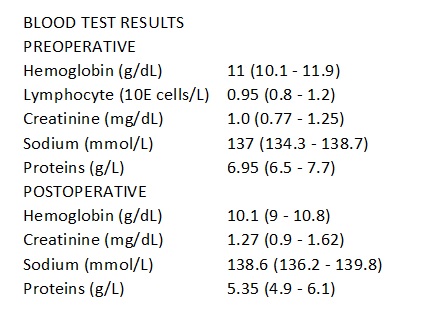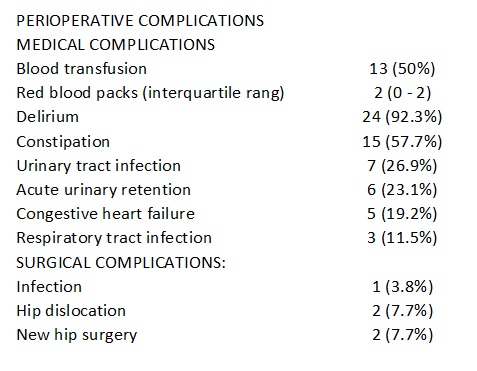Background: Increased life expectancy has raised the number of elderly patients suffering from hip fractures. This frail population and its surgical-related complications are scarcely known. We performed a single-center descriptive study involving centenarian patients to depict their management and complications.
Methods: Centenarians with a hip fracture admitted to a single level I trauma center from 01/JAN/2017 to 31/DEC/2021 were retrospectively evaluated. Data on demographics, baseline patient characteristics, injury and treatment, and clinical outcomes were collected. Proportions and medians (with their interquartile range) were used to describe data.
Results: A total of 3531 hip fracture patients were admitted, being 26 (0.7%) centenarian. One patient was admitted twice due to a bilateral consecutive hip fracture at 108 and 110 years old. Median age was 101 (100-102) years and median age-adjusted Charlson comorbidity index was 6.5 (5 – 7). At baseline, 80.8% were able to walk and 69.3% had experienced a fall in the previous 12 months. Eight (30.8%) patients were partially dependent, 12 (46.2) were moderately dependent and 6 (23.1%) were totally dependent for basic activities of daily living. Patients lived at home with family in 17 (65.4%) cases, alone in 1 (3.9%) case, and in a nursing home in 8 (30.8%) cases. An intracapsular fracture was diagnosed in 15 (57.7%) patients, an extracapsular fracture in 10 (38.5%), and a subtrochanteric in one (3.9%) patient. Osteoporosis was previously diagnosed in 8 (30.8%) patients. Antiaggregating drugs were previously taken in 8 (30.8%) patients, direct oral anticoagulants in 2 (7.7%), benzodiazepines in 9 (34.6%), antipsychotics in 11 (42.3%) and opioids in 2 (7.7%). Blood test results are described in Table 1. Perioperative complications are described in Table 2.In 16 (62.5%) cases patients were able to walk with supervision at discharge. The length of hospital stay was 12 (8 – 15) days. At discharge, patients took 4.5 (3.5 – 6.5) different drugs. Thirteen (50%) patients returned home and 11 (42.3%) were admitted to an intermediate care facility. In-hospital mortality was two (7.7%) patients. Mortality at 3 and 12 months was 30.4% and 50% respectively.
Conclusions: Centenarian patients constitute a small proportion of hip fracture patients but their morbidity is high and their functional status is poor. 12-month mortality is high but recovery after surgery is feasible. Managing these patients requires expertise and taking into consideration previous morbidities to optimize patients and achieve better clinical outcomes.


